I got rhythm. I got music. Gershwin summed it up in 6 words; rhythm is essential to every genre of music (even if it’s Nickelback). But if you’re starting out as a musician what are the essential rhythms you need to know?
In this article we’re going to look at common types of rhythmic patterns in music, and break them down so you understand their DNA.
Before we dive into the various different rhythms you'll need to know a some basic music theory to understand the terms used.
Sound good? As Katy Perry said, let’s get chained to the rhythm.
What Is Rhythm In Music?
A rhythm is a pattern of regular or irregular pulses, notes (or sounds), and silences organized over time. These sounds might be musical notes coming from Lizzo's flute, or untuned pitches coming from Tommy Pridgen's drum kit.
When it comes to musical rhythm it's not the pitches of the notes that matter, but the note values themselves, the silences in between, and how they're arranged on a musical 'grid'.
Elements Of Rhythm In Music
We don't have space to do a deep dive on rhythmic elements, but here's the key things you need to know to understand rhythmic structure.
Time Signature
All western music is organized into beats and measures (sometimes called bars). How these measures are divided up depends on the time signature.
A musical time signature is expressed as two numbers, one over the top of the other, like this:
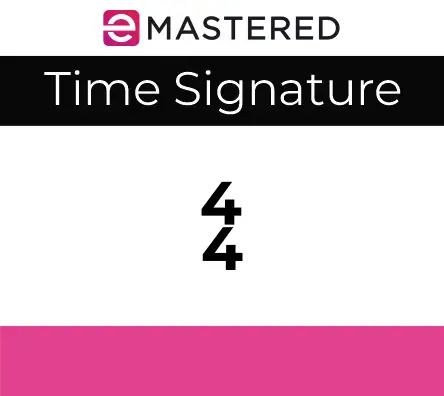
The top number tells you how many beats form a measure. The bottom number tells you what kind of beats they are.
In the above example there are four beats in each measure, and each of those is a a quarter note. Practically all popular music uses this time signature.
Here's some other common time signatures you may come across:
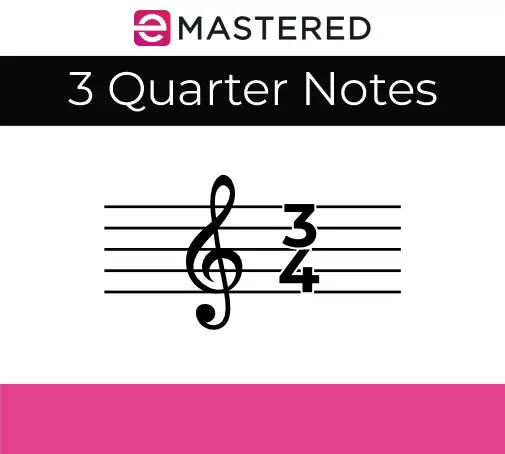
In this time signature there's 3 quarter notes in each measure.
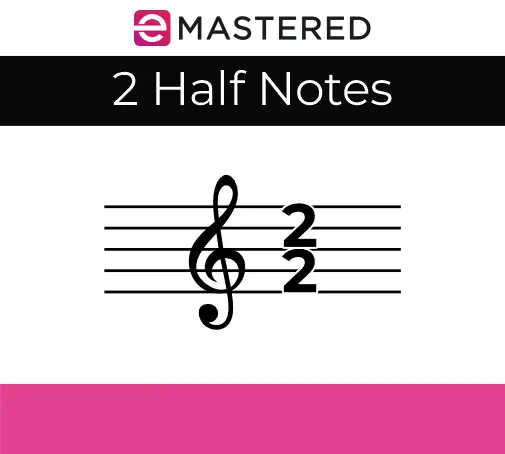
In this time signature there's 2 half notes in each measure. Mathematically it does add up to the same as 4/4, but the feel of the music is much more spacious
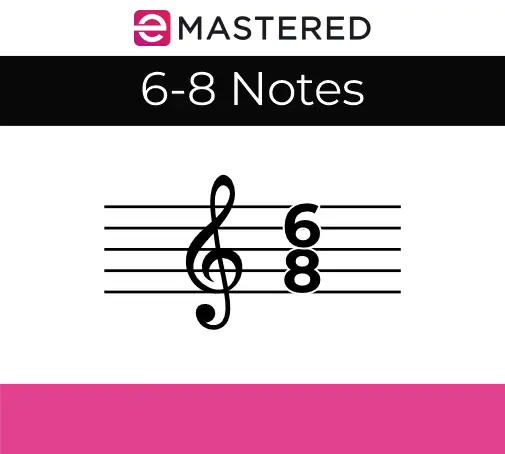
6/8 is another common time signature in contemporary music. There's six eighth notes in each measure.
Meter
Meter in standard Western music theory refers to how beats are grouped together. In duple meter they're in groups of 2 (like the 2/2 example above); in triple meter they're in groups of three, and in quadruple meter beats are grouped in fours.
It's important to note that musical meter doesn't care about note values, just how the beats are grouped. It gives a sense of cohesion to the rhythmic qualities of music.
Strong And Weak Beats
Don't stress - we're almost done with the technicals!
The final piece of the puzzle is understanding that in any given measure there are strong and weak beats.
Typically the first beat of each measure will be a strong one, and the second a weak beat. From there, it depends on your time signature and meter. Further beats may be stronger than others, for example in 6/8 the fourth beat is stronger than the third beat.
A good rhythm combines strong beats and accented traditional weak beats to create memorable rhythmic patterns.
8 Types Of Rhythms In Music
We're going to be looking at common rhythmic patterns in popular music, but you'll also find many of these in classical music.
How To Practice These Rhythmic Patterns
No matter what instrument you play (or what DAW you use) try tapping out these rhythmic patterns using your hands. This way you'll get the essence of the rhythm in your body, and can put them to good use in your music making.
For each rhythm there's a sound example, with an empty measure of click at the top. You'll be told what time signature to count in (in four, in three, etc.). Do this at a steady tempo, repeating the count pattern as you tap out the rhythm with your hand(s).
Then, try tapping the count with one hand while playing the rhythm with the other. Then try adding any suggested accents or variations.
Non Syncopated Rhythmic Patterns
'Four-On-The-Floor'
This type of rhythm refers to a steady beat that is found all over dance music, and many other genres too. In this rhythm you simply play steady quarter notes without any musical accents over four beats.
Here's what it looks like as written music:
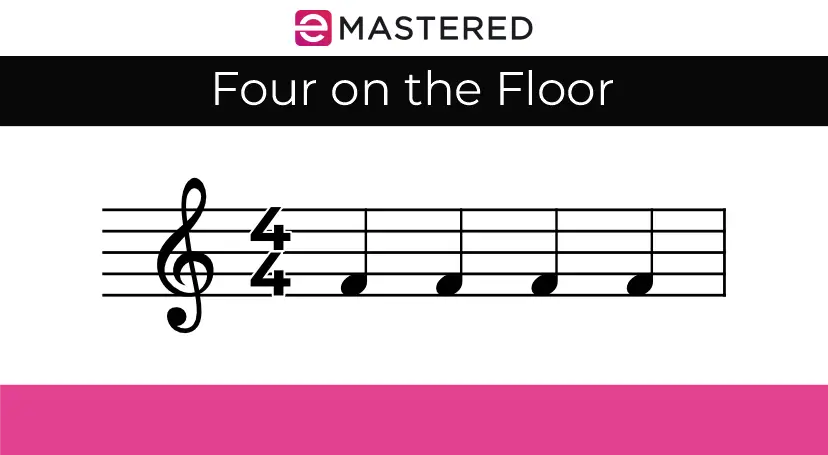
And here's how it sounds:
It's about as basic as you get, but a great way to drive your music forward, and a building block for more complex rhythms.
How to practice:
Count out loud in four ('1-2- 3-4)', and tap each beat out with your right hand. Next, try accenting the first beat of each measure.
'The Off-Beat'
This rhythmic pattern is typical in reggae and it's sub-genres, but is equally useful across many styles of music. This simple rhythm is created by playing on the traditional weak beats of 2 & 4, leaving beats 1 & 3 silent.
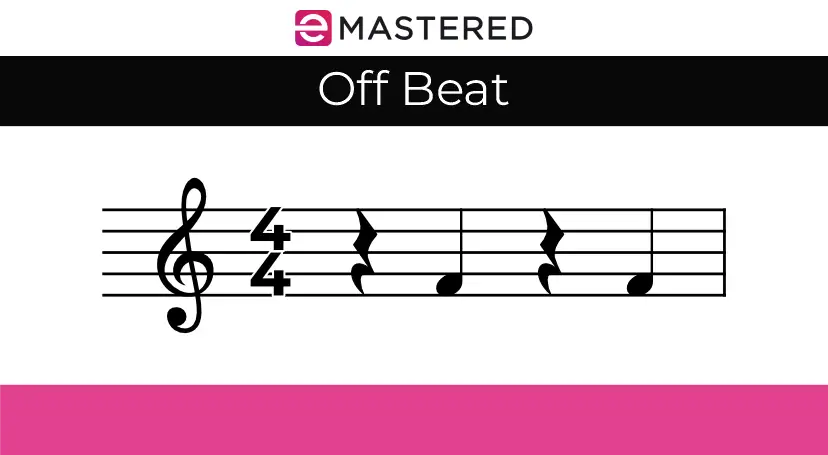
While it's astoundingly simple, it's a great rhythm to use if you're playing a harmonic instrument and want to stay out of the way of more complex rhythms happening around you.
A variation on this musical rhythm is to split one, or both, of the quarter notes into two eighth notes, like this:
How to practice:
Counting in four, tap out beats two and four with your hand. To add the variation simply tap out two even notes for each of beats two and four.
If you want to spice things up, try tapping your left hand on beat three only while your right hand continues on 2 & 4.
'The Ballad'
Another really simple rhythmic pattern that every beginning musician should have down pat is 'The Ballad'. It's comprised of a mainly longer notes, with a little skip in the middle. In musical terms it's a dotted quarter note, an eighth note, and a half note.
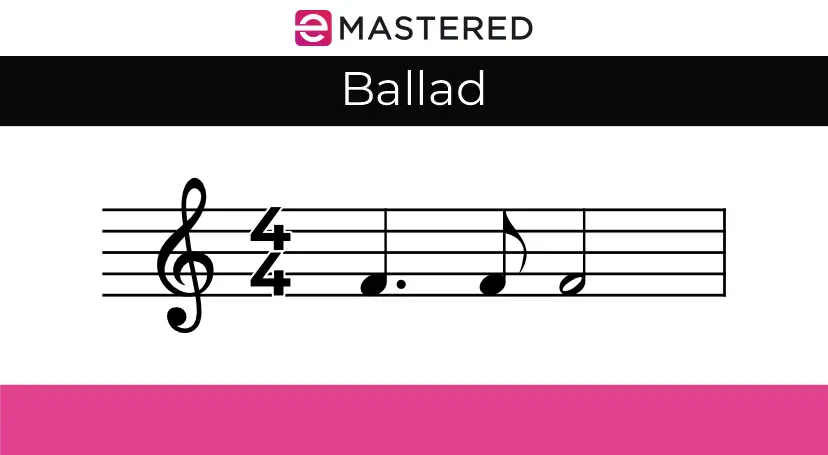
As a variation, the half note at the end can be split into two quarter notes.
You can hear this variation in the bass line for Otis Redding's 'Sitting On The Dock Of A Bay'
How To Practice:
Count in fours, but subdivide the 2nd beat using ' and ': 1-2-&-3-4'.
With your right hand, tap on beats 1, 2&, and 3 (and beat 4 if you're doing the variation). Bring in the left hand to tap out the count. Then try switching roles for each hand!
'The Pulsing 8ths'
Essential for a driving bass groove, classic rock piano or guitar chugs, this rhythmic pattern is simple but requires practice to get things nice and even consistently.
In this rhythm you're playing on each main beat, plus the subdivisions between each beat. So between each beat count insert an 'and', like this: '1-&-2-&-3-&-4-&'.
How to practice:
To begin practice counting in fours, inserting the word 'and' in between each number (or repeat the word 'cola' for each beat - the two syllables will naturally subdivide your beat into two). Then tap out the rhythm with your right hand.
Once you've got a flowing rhythm try tapping the main four beats with your left hand while you play the pulsing eighth notes with your right.
'The Waltz'
Not a lot of contemporary music is written in a 3/4 time signature (an example of triple meter), but good old Billie Eilish put it to good use a few years back.
In this rhythmic pattern you play on the first and last quarter notes in every measure, but add a slight accent (or stress) on the first beat.
You'll find this traditional waltz pattern in a lot of classical music. Strauss' 'Blue Danube' is an example that springs to mind immediately. It also forms the basis of compound duple (6/8) and triple (9/8) meter rhythms.
How to practice:
Remember that in 3/4 time signature there are only three beats in each measure. So this time we'll be counting in threes (1-2-3, 1-2-3, etc.). Tap out the first and last beat with your right hand, but add a slight accent on the first beat.
As a variation try playing beat one with your left hand, and beats 2 and 3 with your right while counting out loud in three.
Syncopated Rhythmic Patterns
If you want to create memorable rhythmic patterns you'll need to dabble with syncopation. In syncopated rhythms the accents fall on typically weaker beats to create a sense of excitement. Think of a syncopated beat as the musical equivalent of a big drop on a roller coaster.
Syncopated rhythms play around with where accented beats fall. We expect to hear certain heavily accented beats in each measure, such as beat one, but when these expectations are broken, for example by accenting the second eighth note in a measure, these heavily accented beats form an exciting musical rhythm.
Here's some classic syncopated rhythms that are worth mastering:
'The Pull'
This rhythm is utilized by the guitar in the Stones' classic 'Honky Tonk Woman' . You'll also find the same rhythm (at a faster tempo) in Bruno Mars' 'Locked Out Of Heaven' .
In this rhythm the first beat is played, followed by the second eighth notes of beats 3 and 4 (3& and 4&).
How to practice:
Count out loud in four, dividing each count into two using the word 'and'. Next tap out beats 1, 3-&, and 4-& with your right hand.
1 - and - 2 - and - 3 - and - 4 - and
Don't forget that the down beat (beat one) comes right after 4&, so this will take some getting used to.
Once you're comfortable with the right hand part, try adding the left hand tapping out the quarter notes while still counting out loud as before.
RH: 1 - and - 2 - and - 3 - and - 4 - and
LH: 1 2 3 4
Finally, try just tapping out these two parts without counting out loud.
'The Billie Jean'
No prizes for guessing where you'll hear this rhythm...
The string pad plays this rhythm throughout the verse of Michael Jackson's classic. It's a great one to master.
The first beat is played, followed by the second eighth note of beat two. And that's it. Repeat at your leisure, or until you get to the pre-chorus.
How to practice:
Counting as you did for 'The Pull', use your right hand to tap out the down beat, and 2&:
1 - and - 2 - and - 3 - and - 4 - and
Then add your left hand tapping out the four main beats of the measure:
RH: 1 - and - 2 - and - 3 - and - 4 - and
LH: 1 2 3 4
Nailed it? If you've got a particularly ambitious sense of rhythm try combining the Billie Jean with the Pull...
'The Viva La Vida'
Again, I'm not hiding anything with the title of this rhythm. Played by the strings in Coldplay's jubilant anthem this two-measure rhythm combines regular strong beats in the first measure with accented weak beats throughout the second measure.
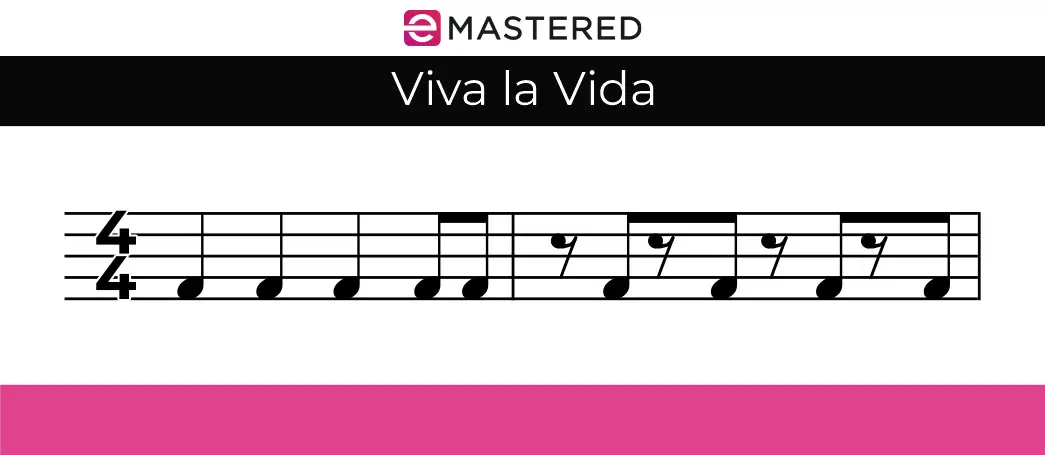
How to practice:
Once again you'll be counting in four, with subdivisions on the second eighth note of each beat.
With your right hand tap out the following:
1 - and - 2 - and - 3 - and - 4 - and | 1 - and - 2 - and - 3 - and - 4 - and
Then add your left hand tapping out beats 1 through 4:
RH: 1 - and - 2 - and - 3 - and - 4 - and | 1 - and - 2 - and - 3 - and - 4 - and
LH: 1 2 3 4 | 1 2 3 4
This one is a trickster, so start nice and slowly.
If you're feeling particularly wild, try combining this one with The Billie Jean. Remember that The Billie Jean is only one measure, so you'll be playing that rhythm twice for the two measures in this one:
RH: 1 - and - 2 - and - 3 - and - 4 - and | 1 - and - 2 - and - 3 - and - 4 - and
LH: 1 2 3 4 | 1 2 3 4
Building More Rhythmic Patterns
Obviously the rhythms you see here are just a drop on the ocean when it comes to rhythmic performances you can create.
Think of the above examples as DNA building blocks for larger and more complex rhythmic musical features.
Complex rhythms tend to be hard to grasp when you first come across them. But if you break them down into their component parts you'll soon get the hang of it.
Having a basic understanding of music theory will be your best ally when it comes to understanding how rhythm in music works.
Rhythmic Terms
Below are some musical rhythm terms you may come across as you continue your journey through rhythm in music.
Polyrhythmic Patterns
Polyrhythms are when two different rhythms are played simultaneously. This creates a dense rhythmic stew in the composition structure.
Polyrhythms are often used in African music, and can be readily heard in a salsa percussion ensemble. Steve Reich is also famous for the use of polyrhythms in his music.
Progressive Rhythm
A progressive rhythm is one that changes very slightly each time it repeats. These small changes accumulate, and eventually result in a new rhythm over time.
Alternating Rhythms
As the name suggests alternating rhythm is when a piece of music switches between rhythms on a regular basis.
The Beatles' 'I Want You' is a great example of using alternating rhythmic ideas for huge dramatic effect.
Harmonic Beats
The term 'harmonic beats' actually refers to an auditory illusion caused when to two or more tones of a similar frequency are played at the same time.
But you may hear the term in place of 'harmonic rhythm'. In this case we're talking about the pace at which chords change in a piece of music.
If for example the chords change every measure in a piece in 4/4, the harmonic rhythm would be described as a whole note.
Mixed Meter
A song that combines time signatures with different meters has what's known as a mixed meter.
Composers regularly mix duple and triple time signatures to create interest and excitement in their music. Stravinsky did, Radiohead did it. Kate Bush did it in the 70s, and again a couple of years back when Stranger Things resurrected 'Wuthering Heights' .
By switching up time signatures you change how the beats are grouped (the meter), throwing off the listener's expectations. It's tricky to master, but when you do it can be immensely satisfying.





